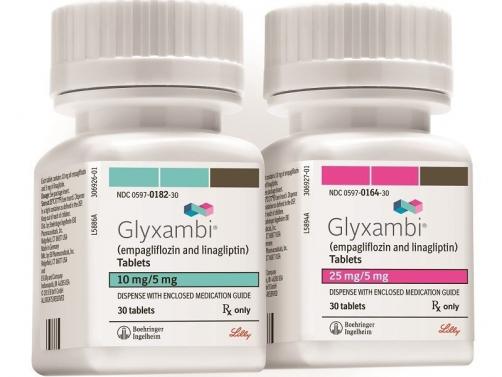The type-2 diabetes drug Glyxambi has been associated with many severe side effects, including acidosis, infections that spread to the blood or kidneys, dehydration, joint pain, rhabdomyolysis, and more.
What You Can Do & How a Lawsuit Can Help
The Schmidt Firm, PLLC is currently accepting Glyxambi induced injury cases in all 50 states. If you or somebody you know was diagnosed with a severe side effect, you should contact our lawyers immediately for a free case consultation. Please use the form below to contact our Defective Drug Litigation Group or call us toll-free 24 hours a day at (866) 920-0753.
UPDATE: Glyxambi Linked to Genital Infections
In August 2018, the FDA issued a Safety Communication after 1 person died and 11 others were hospitalized with a severe genital infection called necrotizing fasciitis of the perineum (Fournier’s gangrene) after taking diabetes drugs in the SGLT2 inhibitor class.
Glyxambi Side Effects
- Bile duct disease
- Bullous pemphigoid
- Gallbladder disease
- Heart failure
- Joint pain
- Pancreatic cancer and pancreatitis
- Rhabdomyolysis
- Fournier’s gangrene (necrotizing fasciitis of the perineum)
FDA Evaluating Rhabdomyolysis Risk
The FDA is evaluating a potential signals of a serious risk and new safety information linking DPP4 diabetes drugs and rhabdomyolysis. This potentially life-threatening kidney side effect was identified by the FDA Adverse Event Reporting System (FAERS) between April and June 2017.
FDA Warning Links Glyxambi and Severe Joint Pain
August 28, 2015 — The FDA is warning that Glyxambi may cause severe, disabling joint pain. Click here to read more.
What is Glyxambi?
One of the newest prescription drugs for type-2 diabetes, Glyxambi, was created by Boehringer Ingelheim and approved by the FDA in February 2015. Glyxambi helps people with diabetes control their blood-sugar levels with a combination of two medications that work in different ways:
- Empagliflozin: Lowers blood-sugar by helping the kidneys excrete it in urine. Sold alone under the brand-name Jardiance and belongs to the sodium-glucose cotransporter-2 (SGLT2) inhibitor class.
- Linagliptin: Lowers blood-sugar by increasing hormones that tell the pancreas to produce more insulin. Sold alone under the brand-name Tradjenta by Eli Lilly & Co. It belongs to the dipeptidyl peptidase-4 (DPP4) inhibitor class.
Glyxambi Side Effects
- Diabetic ketoacidosis
- Kidney infections
- Pyelonephritis
- Urosepsis
- Kidney failure
- Urinary tract infections
Glyxambi and Kidney Failure
Glyxambi should not be used by people with pre-existing kidney disease. Even people without kidney problems should have kidney function tested before and during treatment. The problem is that Glyxambi forces the kidneys to remove extra sugar from the body in urine, which can damage delicate filtration structures and lead to kidney failure. Two of the most common side effects of Glyxambi (dehydration and infections) can both lead to kidney failure. The FDA has issued warnings about kidney failure that began as urinary tract infections.
FDA Warning: Glyxambi and Diabetic Ketoacidosis
On May 15, 2015, the U.S. Food and Drug Administration (FDA) issued a Safety Communication for Glyxambi and other SGLT2 inhibitors.
The FDA was concerned about 20 reports of diabetic ketoacidosis (too much acid in the bloodstream) in patients on SGLT2 inhibitors. This class of drugs has only been on the market since March 2013. Additional cases have been reported since June 2014 and all of the victims had to be hospitalized or receive emergency medical treatment.
In December 2015, the FDA updated the label on Glyxambi to include ketoacidosis. Between March 2013 and May 2015, the agency received 73 reports of the side effect in patients on SGLT2 inhibitors. If you are taking Glyxambi, the FDA recommends:
Patients should stop taking their SGLT2 inhibitor and seek medical attention immediately if they have any symptoms of ketoacidosis, a serious condition in which the body produces high levels of blood acids called ketones. Symptoms of ketoacidosis include nausea, vomiting, abdominal pain, tiredness, and trouble breathing.
What Should I Do?
If you take Glyxambi, the FDA recommends seeking medical attention if you develop symptoms of diabetic ketoacidosis:
“Patients should pay close attention for any signs of ketoacidosis and seek medical attention immediately if they experience symptoms such as difficulty breathing, nausea, vomiting, abdominal pain, confusion, and unusual fatigue or sleepiness.”
SGLT2 Inhibitor Diabetes Drugs Linked to 101 Cases of Ketoacidosis
There have been over 100 reported cases of diabetic ketoacidosis linked to SGLT2 inhibitors as of May 19, according to a warning from the European Medicines Agency (EMA). The agency has also opened a safety investigation.
In some cases, symptoms were relatively mild. The EMA was concerned that this could delay diagnosis:
“All cases were serious and some required hospitalisation. Although diabetic ketoacidosis is usually accompanied by high blood sugar levels, in a number of these reports blood sugar levels were only moderately increased. These uncharacteristic blood levels could delay diagnosis and treatment.”
Diabetic Ketoacidosis (DKA) and Ketoacidosis
Uncontrolled diabetes can cause extremely high blood-sugar levels, which can lead to an emergency medical condition known as diabetic ketoacidosis (DKA).
This condition occurs when the body runs out of insulin and cannot use sugar (glucose) in the bloodstream as a fuel source, and must instead start burning fat. When fat cells break down, they release acidic waste products known as ketones.
Ketones can build up in the body until they cause complications like cerebral edema (swelling and fluid in the brain), coma, and even death.
Symptoms of Ketoacidosis
- Decreased alertness
- Deep, rapid breathing
- Dry skin and mouth
- Flushed face
- Frequent urination or thirst that lasts a day or more
- Fruity-smelling breath
- Headache
- Muscle stiffness or aches
- Nausea and vomiting
- Stomach pain
Glyxambi Class Action Lawsuit
Our attorneys are nationally recognized as class action litigators, but we are not filing a Glyxambi class action against Boehringer Ingelheim. Instead, we are filing individual lawsuits and only accepting cases involving the most serious types of injuries.
Do I have a Glyxambi Lawsuit?
The Schmidt Firm, PLLC is currently accepting Glyxambi induced injury cases in all 50 states. If you or somebody you know was diagnosed with kidney failure or ketoacidosis, you should contact our lawyers immediately for a free case consultation. Please use the form below to contact our Defective Drug Litigation Group or call us toll-free 24 hours a day at (866) 920-0753.
Attention Lawyers: We consider a referral from another law firm to be one of the greatest compliments. If your firm is interested in referring us a case or for us to send you a list of previous award judgments and/or average referral fees, please visit the Lawyer Referral section of our website.


 The Schmidt Firm, PLLC has been recognized as one of the nation’s leading plaintiffs' law firms and handles cases in all 50 states. We are very proud of our legal achievements, but equally self-respecting of our firm's reputation for providing personal attention to each and every client we represent.
The Schmidt Firm, PLLC has been recognized as one of the nation’s leading plaintiffs' law firms and handles cases in all 50 states. We are very proud of our legal achievements, but equally self-respecting of our firm's reputation for providing personal attention to each and every client we represent.

